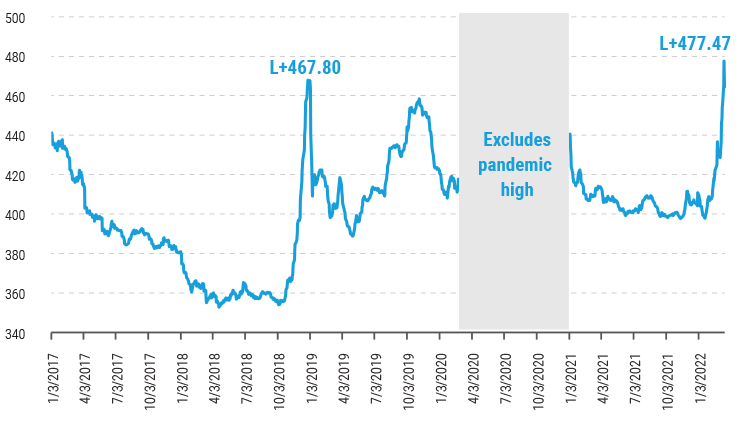Volatility in the broader markets has finally made its way to US leveraged loans, with uncertainties emanating from the Russia-Ukraine conflict causing many market participants to pull back on risk. The result has been weaker demand for loans from retail loan funds and collateralized loan obligations (CLOs) after several months of strong inflows and record-breaking CLO issuance in 2021. Amid this volatility, loan spreads have widened to levels not seen since the capital market selloff at the end of 2018 (with the exception the onset of Covid-19 in 2020). We believe this has provided potentially compelling entry points in leveraged loans.
Recent Spread Widening Has Created Potentially Compelling Entry Points in Leveraged Loans
US loan spread to maturity (bps)

Compared with other global risk assets, the issuer base for US loans has shown to be relatively insulated from the Russia-Ukraine conflict, consisting largely of small- and mid-cap issuers with a limited global presence. While indirect impacts from higher commodity prices are expected to affect some issuers and sectors, we believe this risk is manageable and will hit profitability more than overall credit quality.
We expect the recent softening in retail fund inflows and CLO demand to prove temporary and believe loans remain well positioned given the multiple rate hikes expected from the Fed this year. The credit environment remains benign, with default rates near record lows and only a small number of distressed credits in the market.1 That said, we expect year-over-year earnings growth to slow as issuers contend with inflation and supply chain issues.
We see further upside potential in the leveraged loan market and expect strong demand to reassert itself – and critically, greater differentiation among credits is providing opportunities to take advantage of the recent dislocation through active credit selection.
Footnotes
1 Source: S&P/LSTA Sheet as of 28 February 2022. The latest trailing-12-month default rate is 0.19%; current percentage of distressed credits is 1.49%; historical low for defaults is 0.15% (as of June 2007).
Disclosure
Investing involves risk, including possible loss of principal. The information presented herein is for illustrative purposes only and should not be considered reflective of any particular security, strategy, or investment product. It represents a general assessment of the markets at a specific time and is not a guarantee of future performance results or market movement. This material does not constitute investment, financial, legal, tax, or other advice; investment research or a product of any research department; an offer to sell, or the solicitation of an offer to purchase any security or interest in a fund; or a recommendation for any investment product or strategy. PineBridge Investments is not soliciting or recommending any action based on information in this document. Any opinions, projections, or forward-looking statements expressed herein are solely those of the author, may differ from the views or opinions expressed by other areas of PineBridge Investments, and are only for general informational purposes as of the date indicated. Views may be based on third-party data that has not been independently verified. PineBridge Investments does not approve of or endorse any re-publication or sharing of this material. You are solely responsible for deciding whether any investment product or strategy is appropriate for you based upon your investment goals, financial situation and tolerance for risk.

